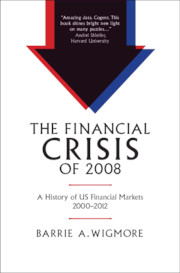Book contents
- The Financial Crisis of 2008
- Studies in Macroeconomic History
- The Financial Crisis of 2008
- Copyright page
- Dedication
- Contents
- Introduction
- 1 The Heritage of the Hi-Tech Bubble 2000–2004
- 2 The Stretch for Higher Returns 2004–2006
- 3 The Impending Storm – 2007
- 4 The Crisis – 2008
- 5 What Caused the Crisis?
- 6 The Initial Obama Administration 2009
- 7 Recovery 2010–2012
- 8 Epilogue 2012–2016
- Acknowledgments
- Charts
- Tables
- Acronyms
- Bibliography
- Index
- Studies in Macroeconomic History
- Plate Section
2 - The Stretch for Higher Returns 2004–2006
Published online by Cambridge University Press: 07 October 2021
- The Financial Crisis of 2008
- Studies in Macroeconomic History
- The Financial Crisis of 2008
- Copyright page
- Dedication
- Contents
- Introduction
- 1 The Heritage of the Hi-Tech Bubble 2000–2004
- 2 The Stretch for Higher Returns 2004–2006
- 3 The Impending Storm – 2007
- 4 The Crisis – 2008
- 5 What Caused the Crisis?
- 6 The Initial Obama Administration 2009
- 7 Recovery 2010–2012
- 8 Epilogue 2012–2016
- Acknowledgments
- Charts
- Tables
- Acronyms
- Bibliography
- Index
- Studies in Macroeconomic History
- Plate Section
Summary
In the years between 2002–06, especially in 2004–06 as the economy recovered, institutional investors expanded their “alternative investments” by $7.7 trillion, most notably in commercial real estate ($2.6 trillion), private residential mortgage-backed securities (RMBS) ($1.6 trillion), high yield corporate debt and leveraged loans ($1.1 trillion), private equity ($0.9 trillion), and hedge funds ($0.8 trillion).
- Type
- Chapter
- Information
- The Financial Crisis of 2008A History of US Financial Markets 2000–2012, pp. 34 - 115Publisher: Cambridge University PressPrint publication year: 2021

